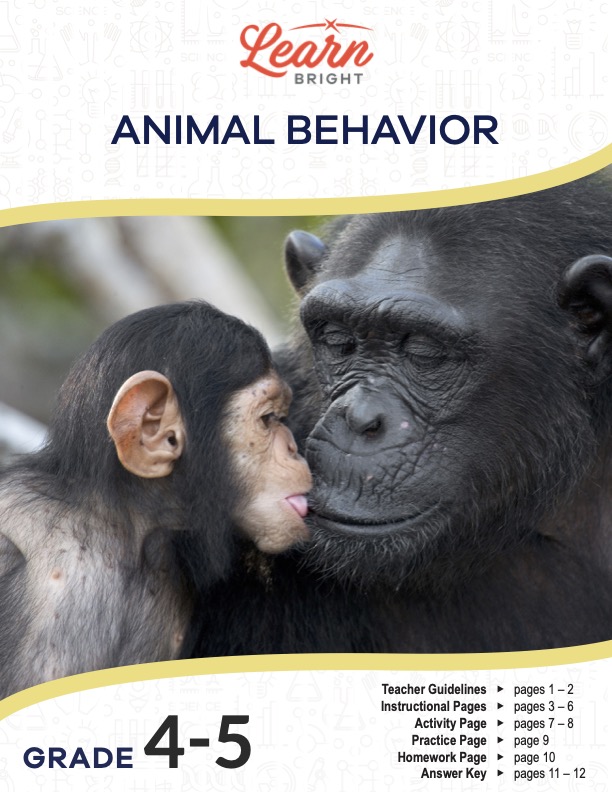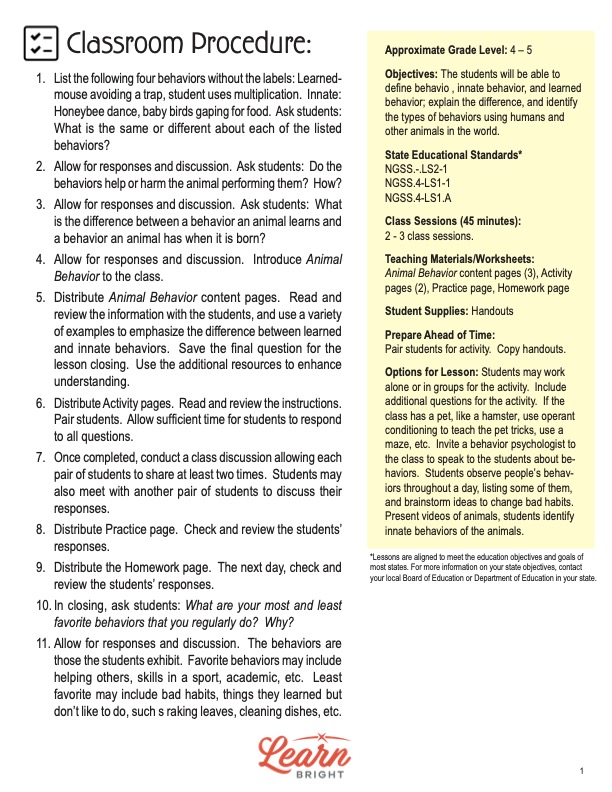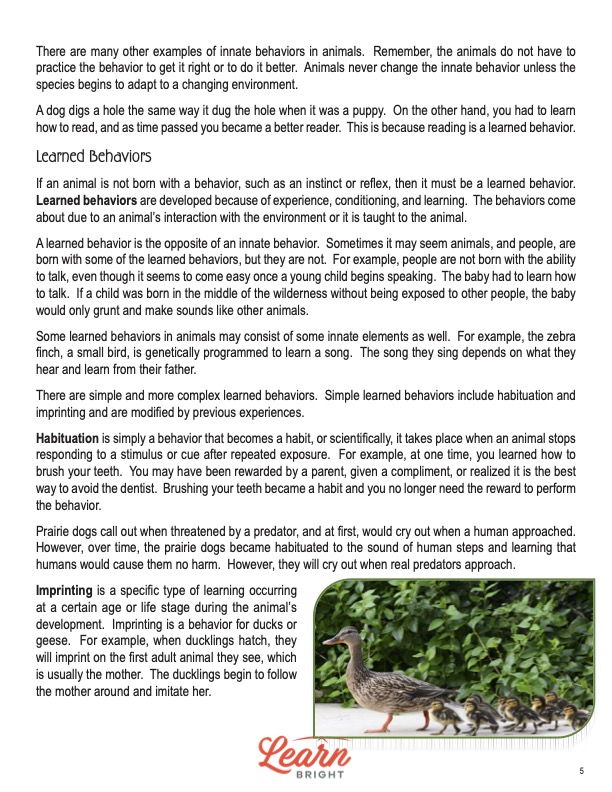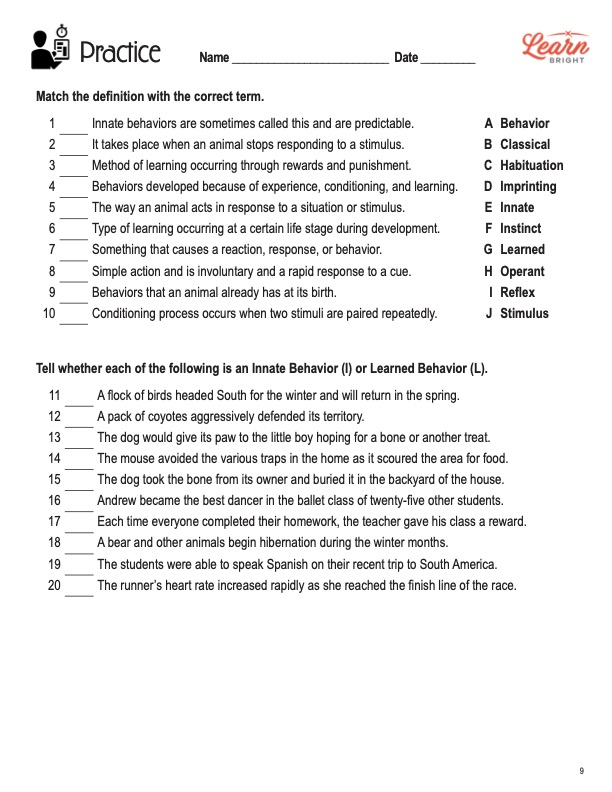Description
What our Animal Behavior lesson plan includes
Lesson Objectives and Overview: Animal Behavior explores the two types of behavior animals demonstrate: innate and learned. Students will discover the difference between the two types and will be able to identify whether or not an animal’s actions represents one or the other. They will also learn that the same concept applies to humans. Sometimes we do things because of a natural instinct. Other times, we learned to do something specific because of our life experience or conditioning. This lesson is for students in 4th grade and 5th grade.
Classroom Procedure
Every lesson plan provides you with a classroom procedure page that outlines a step-by-step guide to follow. You do not have to follow the guide exactly. The guide helps you organize the lesson and details when to hand out worksheets. It also lists information in the yellow box that you might find useful. You will find the lesson objectives, state standards, and number of class sessions the lesson should take to complete in this area. In addition, it describes the supplies you will need as well as what and how you need to prepare beforehand. This lesson does not require any additional supplies apart from the handouts. If you want to pair off students for the activity before the lesson you are welcome to. However, it may be easier to do so as you hand out the activity worksheet instead.
Options for Lesson
If you have time for extra activities or want to adjust the lesson at all, check out the “Options for Lesson” section on the classroom procedure page. There are several suggestions that you can incorporate into this lesson. One option is to invite a behavioral psychologist to the class to speak to the students about the subject matter. If you happen to have a class pet, such as a hamster, you can try using operant conditioning to teach it tricks or how to use a maze. Another option is to have students observe people’s actions throughout the day, write them down, and brainstorm ideas on how to change bad habits. You could also present videos of animals and have students identify whether their actions represent innate or learned behaviors. Finally, if you want to extend the activity a little bit, you can add more questions to the worksheet.
Teacher Notes
This page provides an extra paragraph of information or guidance for the lesson. It explains that people often confuse the two types of behaviors. The lesson can help students understand the difference more clearly and better identify the actions that are innate and not learned and vice versa. You can research further on the subject and provide extra data as well. Use the blank lines to write any additional ideas or notes for the lesson.
ANIMAL BEHAVIOR LESSON PLAN CONTENT PAGES
Introduction to Animal Behavior
The Animal Behavior lesson plan includes four content pages. The lesson begins by listing a number of actions different animals or people do. Birds build nests and dogs roll over and chase things. Spiders build intricate webs, people blink and talk to each other, and bees dance. Every action is a behavior. Students will learn that behaviors are ways that animals or people act in response to a certain situation or stimulus. These actions are simply how animals interact with other animals or their environment.
Students will also discover that there is a reason for every action. A bird will build a nest because it needs somewhere to live and raise its young. Dogs sit or roll over because they expect a treat or pat on the head. People blink to moisten their eyes, and spiders build webs both to catch their prey and protect themselves.
There are differences among these actions though. People learn to read, but they don’t learn to blink. Dogs learn to roll over for a treat, but they naturally know how to dig. Students will see that they learned to read and write and talk because their parents or teachers taught them how to do so. On the other hand, blinking and breathing and grasping for things just happen naturally because they are reflexes. Thus, behaviors that an animal simply knows how to do are innate. Those that it learns how to do are learned.
Innate
The lesson defines innate behaviors as those that an animal already has at its birth. An interesting fact students will learn is that the more intelligent an animal is, the fewer innate behaviors it will manifest. Humans are the most intelligent creatures, and we have the fewest innate reflexes. Most human actions are learned behaviors. The only innate actions we have are reflexes, or involuntary and rapid responses to a cue or stimulus. A stimulus is something that causes a reaction or response.
The lesson gives the example of the doctor tapping a spot on the knee with a small hammer. Typically, the knee will automatically jerk. The stimulus is the hammer hitting the knee. The behavior is the reflex of the leg giving a little involuntary kick, which makes the action innate. Similarly, blinking, breathing, and other functions and reflexes of the body are also innate.
Other animals have more innate behaviors, and they occur naturally in all the animals of a given species. For instance, all dogs know how to dig holes. The very first time they try, they succeed. They need no amount of practice to get it right. These are instincts, and the instincts are predictable. It is possible for these innate actions to change over a long period of time. Animals may need to adapt to new environments, for instance, or else they may die off. The lesson provides a list of examples in a chart that students can review. These include baby turtles digging out of the sand, caterpillars building cocoons, and baby birds gaping for food.
Learned
Next, students will learn about learned behaviors, those actions that are neither reflexes or instincts. These are the things animals do simply because of their experiences, conditioning, and learning. They develop in an animal or person either because of certain interactions they had with the environment or because someone taught them the behavior. Some of these seem like they would be innate, such as talking. However, that is not the case at all. A baby has to learn how to talk. If a child grows up in the middle of the wilderness without any human exposure, it would only mimic sounds of other animals it encounters.
Students will learn, however, that some learned behaviors have certain innate qualities or elements. The zebra finch is a great example of this. The small bird is genetically programmed to learn a song. The song it sings, however, depends on what they hear and learn from its father. In addition, there are both simple and complex learned actions. Those in the simple category include habituation and imprinting.
Habituation: These are behaviors that become habits. In other words, when an animal no longer responds to a cue after repeated exposure, the action has become a habit. The lesson explains to students that they learned how to brush their teeth at one point by getting rewards, compliments, etc. from parents. Eventually, they brushed their teeth out of habit without expecting any kind of reward or compliment.
Imprinting: These behaviors are specific types of learning that occur at a certain age or stage of life during an animal’s development. When ducklings hatch, they will imprint on the first adult animal they see, which is usually the mother. They then begin to follow the mother around and imitate the things she does. While it perhaps seems innate, it is not. If ducklings first see a human, they will imprint on the human and follow him or her around as they would their real mother. If this behavior were innate, the ducklings would ignore the human and find their mother instead.
Conditioned Behaviors
Students will then learn about the two types of conditioned behaviors: classical and operant. Both result from associative learning, something that happens when a new response associates to a particular stimulus. This actually defines nearly all learning except for habituation.
Classical conditioning is a learning process that occurs when two stimuli pair repeatedly. Operant conditioning is a method of learning that occurs through rewards and punishment of behavior. The lesson provides an example to explain both types. Students will discover that people most often use operant conditioning when they train animals. A person may give a dog a treat for performing a certain action, like rolling over, for example.
ANIMAL BEHAVIOR LESSON PLAN WORKSHEETS
The Animal Behavior lesson plan contains three worksheets. The goal is to help students solidify their understanding of the concepts in different ways. Refer to the classroom procedure page to know when to administer each worksheet. There are also answer keys for both the practice and homework worksheets included with this lesson plan. They show the correct answers in red.
ANIMAL BEHAVIOR ACTIVITY WORKSHEET
For the activity, students will work in pairs to respond to five prompts. They will need to use critical thinking skills to apply what they learned to the activity. You can have them work in groups or alone if you prefer.
INNATE OR LEARNED PRACTICE WORKSHEET
There are two sections for the practice worksheet. The first section requires students to match terms from a word bank to the correct definition. There are 10 statements in total. The second section requires students to mark 10 descriptions as innate (I) or learned (L).
T/F AND FILL IN THE BLANK HOMEWORK ASSIGNMENT
The homework assignment first requires students to mark 10 statements are true (T) or false (F). Next, they will review a word bank and fill in the blanks of 10 more statements.
Worksheet Answer Keys
The final pages of the document are answer keys for the practice and homework worksheets. The correct responses are in red to make it easy to compare to students’ responses. If you choose to administer the lesson pages to your students via PDF, you will need to save a new file that omits these pages. Otherwise, you can simply print out the applicable pages and keep these as reference for yourself when grading assignments.










